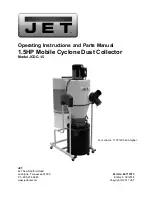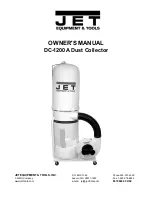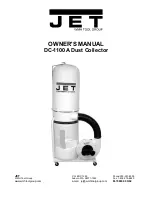
5
OAS Vortex DCS Owner’s Manual O.A.S. 2013
c
Sander Cyclones
- General Tips
Filter Cleaner
Crank
Spun-Bond
Polyester Filter
Cartridge
Stack Pipe
Clamp w/
Gasket
Clear
Cone
Filter
Latch
8” Clamp
Cyclone
Waste
Outlet
Keep an eye on the Clear Cone during operation. Material should be
swirling and exiting the cone. If material is accumulating in the cone, shut-
down the sander. Remove the hose from the cyclone waste outlet. Make
sure the vacuum is on and all hoses are connected. Remove the Clear
Cone and dump out accumulated dust. Check filter and clean if neces-
sary. Reassemble and you’re ready to sand.
Make sure Stack Pipe Clamp is tightened down so there are no leaks. If it
is too loose you you will see dust around the clamp on the Stack.
When rotating the cyclone on the Sander, turn Sander off, loosen clamp,
rotate and tighten. Rotating while Sander is on will cause a puff of dust to
escape at the clamp.
2 1/2” I.D.
2 5/8” O.D.
2 5/8” O.D.
Filters
- All HEPA Filtration
Filters must be cleaned with compressed air after or before every job. This maintenance
will ensure your dust collector is running efficiently. Follow filter cleaning instructions on
pg, 3.
Oneida’s filters are extremely durable and reusable. Their lifespan is normally between 40 - 100 jobs. Regular and thorough
cleaning with compressed air can extend filter life. All filters are a high efficiency, spun-bonded, polyester filter media with
a teflon-like coating to aid cleaning. These filters have been 3rd party tested to be 99.9% efficient in filtering 0.2 - 2 micron
dust. 1 micron = 0.0000394 inch.
Filter cleaners allow the operator to go a longer period of time between cleaning the filters
with compressed air. Whenever the machine is shut down, changing paper, taking a
break, etc., give the crank a few turns at a few different heights to drop material out of the
filter.
Filters can be washed out with water after being blown out. They should be
completely
dry before re-installing.
Filter Cleaner is a hand-operated filter cleaning mecha-
nism that is attached to the filter. When turned, the crank
rotates a teflon-like flapper inside the filter that hits the
pleats and drops material down to the bottom of the
cyclone. This is a quick way to maintain your filters on the
job and must be done when the Sander is off. It does not
take the place of cleaning filters with compressed air.

















